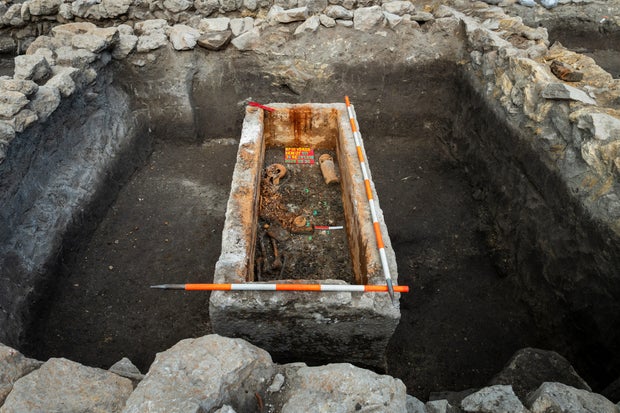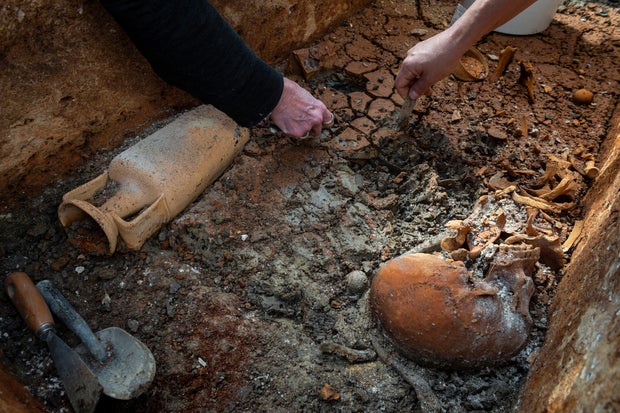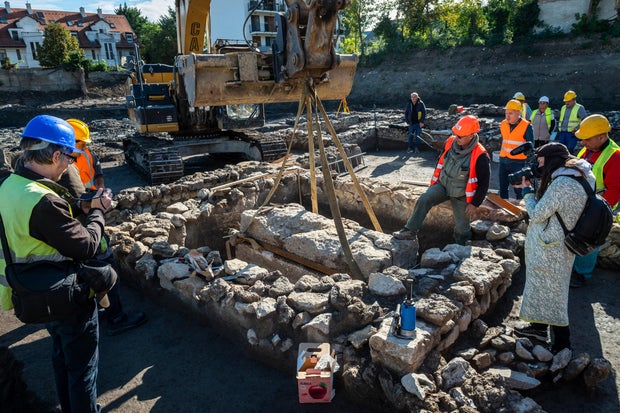A remarkably well-preserved Roman sarcophagus has been unearthed in Hungary’s capital, providing a uncommon window into the lifetime of the younger lady inside and the world she inhabited round 1,700 years in the past.
The sarcophagus was untouched by looters and sealed for hundreds of years. It was discovered with its stone lid mounted in place, secured by metallic clamps and molten lead. When researchers fastidiously lifted the lid, they uncovered an entire skeleton surrounded by dozens of artifacts.
“The peculiarity of the discovering is that it was a hermetically sealed sarcophagus. It was not disturbed beforehand, so it was intact,” mentioned Gabriella Fényes, the excavation’s lead archaeologist.
Archaeologists with the Budapest Historical past Museum found the limestone coffin throughout a large-scale excavation in Óbuda, a northern district of town that after fashioned a part of Aquincum, a bustling Roman settlement on the Danube frontier.
The coffin lay among the many ruins of deserted homes in 1 / 4 of Aquincum vacated within the third century and later repurposed as a burial floor. Close by, researchers uncovered a Roman aqueduct and eight easier graves, however none approaching the richness or pristine situation of the sealed tomb.
Gabor Lakos, Budapest Historical past Museum by way of AP
Holding with Roman funerary customs, the sarcophagus held an array of objects: two fully intact glass vessels, bronze figures and 140 cash. A bone hair pin, a chunk of amber jewellery and traces of gold-threaded cloth, together with the dimensions of the skeleton, level to the grave belonging to a younger lady.
The objects, Fényes mentioned, have been “objects given to the deceased by her family members for her everlasting journey.”
“The deceased was buried very fastidiously by her family members. They will need to have actually liked who they buried right here,” she mentioned.
Anthropologists are actually analyzing the younger lady’s stays, which is predicted to disclose extra about her age, well being and origins. However even now, the grave’s placement and abundance of artifacts supply robust clues.
The sarcophagus and its contents “positively make it stand out,” mentioned Gergely Kostyál, a Roman-period specialist and coleader of the undertaking. “This in all probability signifies that the deceased was well-to-do or of a better social standing.”
Gabor Lakos, Budapest Historical past Museum by way of AP
“It’s really uncommon to discover a sarcophagus like this, untouched and by no means used earlier than, as a result of within the fourth century it was widespread to reuse earlier sarcophagi,” he added. “It’s fairly clear that this sarcophagus was made particularly for the deceased.”
Excavators additionally eliminated a layer of mud roughly 4 centimeters, or 1.5 inches, thick from contained in the coffin that Fényes hoped may comprise extra treasures.
Photos confirmed golden jewellery discovered on the website, in addition to a glass flask, a glass jar and different intact objects after they have been collected. Pictures additionally confirmed archaeologists analyzing the cranium of the girl, alongside different stays. Different photos confirmed staff lifting the lid of the sarcophagus utilizing heavy equipment, after securing it.
Gabor Lakos, Budapest Historical past Museum by way of AP
Support Greater and Subscribe to view content
This is premium stuff. Subscribe to read the entire article.

















